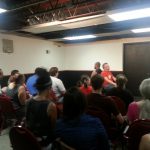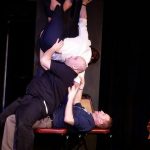
If you’ve ever visited Austin as an improvisor, you’ve probably visited The Hideout Theatre. It’s been one of the mainstays of the Austin scene for many years. And although great shows have gone up consistently for all those years a lot has changed recently. There’s been a much larger reach from the theatre to get involved not only with the other theatres in Austin, but theatres and festivals around the world. This is not coincidental to the fact that the four members of Parallelogramophonograph have taken a more active role in the theatre. Of all the groups in the world, PGraph is one of the leaders – in my opinion – in not only innovation within their shows, but in their openness and excitement to share ideas with folks everywhere and anywhere. Although the group, and many others from The Hideout have traveled the world, they’re starting on a new journey to bring a little of the world to Austin. I was lucky enough to get a few thoughts from Roy Janik about the project and about how you, reading this article right now, can get involved.
The International Improv Experience is a very ambitious idea, but also one that is very accessible for people around the world. A lot of our readers aren’t familiar with the project. How does it work and how did the idea come about?
 In the past few years, Parallelogramophonograph (PGraph, my 4 person improv group) has been lucky enough to do a lot of international traveling- to Montreal, to Vancouver, to London, to Paris, and to Australia. These trips are always bittersweet, because we make these amazing friends that we may not see again for years to come. But the trips are also amazing because you start to get a sense for just how universal improv’s growth is, and how much we all share in common with each other.
In the past few years, Parallelogramophonograph (PGraph, my 4 person improv group) has been lucky enough to do a lot of international traveling- to Montreal, to Vancouver, to London, to Paris, and to Australia. These trips are always bittersweet, because we make these amazing friends that we may not see again for years to come. But the trips are also amazing because you start to get a sense for just how universal improv’s growth is, and how much we all share in common with each other.
When I was planning the 2014 Hideout season, I wanted to do something that would enable me to work with all these lovely people again, and to give Austinites a small taste of what we’d found when traveling. The name “The International Improv Experience” sprang to my mind unbidden, and I slotted it in without really knowing the details. So it’s a show based on a mission statement, not a format.
We’ve tinkered with video collaboration in the past. PGraph has a sci-fi show called Eris 2035. In that, we send an open call to improvisers around the world to record “video letters” to loved ones in space, which we then incorporate into the show. So we knew that that idea worked on a small scale, at least.
The way the International Improv Experience works is this: Participating groups issue video challenges, which they send to me online ahead of time. During the show we select a country at random, play one of their videos, and then do whatever they’ve challenged us to do. After the intermission, we do a longer narrative inspired by a particular country’s storytelling tradition (explained in another video).
To make things more focused, I’ve outlined general types of challenges for groups to submit- scene challenges, guided tours, challenges related to landmarks, animals, language lessons, and so on. You can see the example page here: http://hideouttheatre.com/international-improv-experience-welcome
The Hideout has definitely been part of the international community for a while now. How has that collaboration with theatres around the world help grow The Hideout and the Austin Community?
 It’s been accelerating lately, and you can see it in small ways. The most obvious way is that we get a lot more international visitors. Tim Redmond from Australia and Jonathan Monkhouse from London have both come over to be a part of our 40+ hour improv marathon. Scott Hunter just visited from Vancouver. Jules and Heather of 10,000 Million Love Stories in the UK came for The Improvised Play Festival and taught workshops. And we’ve got several more visits planned before the end of 2014.
It’s been accelerating lately, and you can see it in small ways. The most obvious way is that we get a lot more international visitors. Tim Redmond from Australia and Jonathan Monkhouse from London have both come over to be a part of our 40+ hour improv marathon. Scott Hunter just visited from Vancouver. Jules and Heather of 10,000 Million Love Stories in the UK came for The Improvised Play Festival and taught workshops. And we’ve got several more visits planned before the end of 2014.
Another HUGE way that traveling and being a part of the international community has helped has been in the direct exchange of ideas. The Fancy-Pants Mashup, one of our more popular ongoing shows, is based on a show we participated in when visiting ProjectProject in Toronto several years ago. An energetic warmup we picked up in London a month ago is now being taught to the kids in our summer camps.
Every single time we travel or reach out to a theater outside of Texas, we make friends and we learn something.
The project is obviously a lot of fun for people sending in videos. What are you hoping your audiences will take away from the project?
 I want audiences to leave with a sense that by coming to our theater, they’ve tapped into something greater than just a pleasant night’s diversion. It’s something every improviser knows, but it’s hard to convey that, or to make the audience care about that. But with these videos, audience members can see for themselves just how charming, diverse, and widespread the international community is.
I want audiences to leave with a sense that by coming to our theater, they’ve tapped into something greater than just a pleasant night’s diversion. It’s something every improviser knows, but it’s hard to convey that, or to make the audience care about that. But with these videos, audience members can see for themselves just how charming, diverse, and widespread the international community is.
This isn’t the first large scale project from some of the folks creating this. As more young theatres are beginning to find their identity, what advice would you give them for trying more bold projects of their own?
 The most important piece of advice I can give is to ignore the well-meaning naysayers- those people that are on your side but have a billion reasons why you shouldn’t do that dramatic/narrative/genre/weekly/experimental/cross-theater/international (take your pick) show. You know the excuses: Your city’s audiences aren’t sophisticated enough, your regular fans are expecting comedy, plot is too hard, you need to build up your own audience before reaching out to other groups, you’ll burn out, we tried that 3 years ago and it didn’t work, etc, etc… ESPECIALLY ignore that naysayer if he lives in your own head.
The most important piece of advice I can give is to ignore the well-meaning naysayers- those people that are on your side but have a billion reasons why you shouldn’t do that dramatic/narrative/genre/weekly/experimental/cross-theater/international (take your pick) show. You know the excuses: Your city’s audiences aren’t sophisticated enough, your regular fans are expecting comedy, plot is too hard, you need to build up your own audience before reaching out to other groups, you’ll burn out, we tried that 3 years ago and it didn’t work, etc, etc… ESPECIALLY ignore that naysayer if he lives in your own head.
It’s funny. We’re trained in improv to face our fear, but fear keeps creeping in. If it can’t get a foothold in the improv itself, it’ll creep into the admin side of things. At the Hideout, I hesitated adding more shows to our schedule because I was afraid doing that would dilute our audience. But every time I do, it’s been totally fine.
On the more practical side, here’s a quick list of pointers we’ve found useful for launching larger/more ambitious projects:
- Do what you’re inspired to do. If no one is jazzed about an idea, even if it’s been successful before, table it.
- Make sure your concept has a hook you can explain on a poster that makes sense to someone who knows nothing about improv.
- Don’t overcomplicate the format of your show. Even if you’re doing a sprawling Dickensian epic, aim for hitting the appropriate tone and characters rather than the specific chronological beats of a story.
- Be willing to change everything. Once rehearsal starts the show will reveal itself, and you need to be willing to let go of your initial, perfect concept.
- Set the audience’s expectations as early as possible, especially if the show you’re doing is unusual for your group. If you’re doing a tragedy, don’t promise a hilarious night of laughs on your poster. Tailor your hosting to fit the tone and style of the show as well. With a lot of shows I direct, I will straight up tell the audience “The show you’re about to see is unlike anything The Hideout has done before, and here’s why.”
Of course we couldn’t have an article about a video project without a video. Here’s the project.
Kudos to Roy and all of the Hideout staff and performers for not only putting together such a large project, but reaching out to share with the rest of the improv community.
If your theatre would like to get involved, create your own videos or if you’re in Austin, head on down and catch the shows live.

 This past weekend, I was very fortunate to be able to teach and perform with my group Switch Committee at the HUGE Theater in Minneapolis, Minnesota for Eighth annual Twin Cities Improv Festival. We had met Butch Roy, Co-Founder and Executive Director of Huge Theater, and Hannah Catherine Wydeven when they were performing as Michael Keaton at the Phoenix Improv Festival in April. We had talked about the possibility of Switch Committee coming out to Minnesota for the festival to which we all replied, in unison, “ABSOLUTLEY.” You could call it networking, but I just call it meeting new friends with the same interests as ours. Both of them are great. For the trip, we left at 9:30pm on Friday night and made the 6 ½ hour trek up to Minnesota. Despite some bumper to bumper nighttime construction and one lane highway traffic for a little while, it wasn’t that bad. We actually spent the ride singing 90s hits while I played DJ using Spotify. One continuous song I kept playing, for no reason whatsoever, was Haddaway’s “What is Love”. More on that…never.
This past weekend, I was very fortunate to be able to teach and perform with my group Switch Committee at the HUGE Theater in Minneapolis, Minnesota for Eighth annual Twin Cities Improv Festival. We had met Butch Roy, Co-Founder and Executive Director of Huge Theater, and Hannah Catherine Wydeven when they were performing as Michael Keaton at the Phoenix Improv Festival in April. We had talked about the possibility of Switch Committee coming out to Minnesota for the festival to which we all replied, in unison, “ABSOLUTLEY.” You could call it networking, but I just call it meeting new friends with the same interests as ours. Both of them are great. For the trip, we left at 9:30pm on Friday night and made the 6 ½ hour trek up to Minnesota. Despite some bumper to bumper nighttime construction and one lane highway traffic for a little while, it wasn’t that bad. We actually spent the ride singing 90s hits while I played DJ using Spotify. One continuous song I kept playing, for no reason whatsoever, was Haddaway’s “What is Love”. More on that…never.  Following breakfast, we arrived at HUGE and I must say, this place is BEAUTIFUL. I loved every single detail about the theater. There were writings on the wall (because the walls had dry-erase paint) and writings on the floor. Yes, there are things written on the floor like the words “theater” and “restrooms.” The reasoning behind this is because, according to Butch, “People tend to look down when they walk into a new place.” That’s genius! In addition, another cool factor, at the right angle (standing outside in front), you can see that the inside of the theater says ‘HUGE’ because there are giant letters on each of the walls inside.
Following breakfast, we arrived at HUGE and I must say, this place is BEAUTIFUL. I loved every single detail about the theater. There were writings on the wall (because the walls had dry-erase paint) and writings on the floor. Yes, there are things written on the floor like the words “theater” and “restrooms.” The reasoning behind this is because, according to Butch, “People tend to look down when they walk into a new place.” That’s genius! In addition, another cool factor, at the right angle (standing outside in front), you can see that the inside of the theater says ‘HUGE’ because there are giant letters on each of the walls inside. 



 Later that night we performed and jumped on and off of pretty much everything in the theater. We threw our bodies all over the stage and hung from the rafters because in that scene (justifiably) the building was on fire and later it was because we were stuck in a tree house. That scene involved carefully dropping me over the wall and down into my partner’s arms. A scene that, if it went wrong, would probably have been my last improv scene ever.
Later that night we performed and jumped on and off of pretty much everything in the theater. We threw our bodies all over the stage and hung from the rafters because in that scene (justifiably) the building was on fire and later it was because we were stuck in a tree house. That scene involved carefully dropping me over the wall and down into my partner’s arms. A scene that, if it went wrong, would probably have been my last improv scene ever.  Following the festival, there was an after-party at one of the local performer’s (Beard Men Improv) houses. Just another example of how warm and welcoming the Minnesota improv community is to out-of-town performers. We were invited to come to someone’s house, who we didn’t know, to hang out simply because we were all a part of a something together.
Following the festival, there was an after-party at one of the local performer’s (Beard Men Improv) houses. Just another example of how warm and welcoming the Minnesota improv community is to out-of-town performers. We were invited to come to someone’s house, who we didn’t know, to hang out simply because we were all a part of a something together. 






![improvutopiaeast[1]](http://www.nationalimprovnetwork.com/wp-content/uploads/improvutopiaeast1.png)
![DSC3092[1]](http://www.nationalimprovnetwork.com/wp-content/uploads/DSC30921-300x198.jpg) East coast improvisors have very different challenges than west coast improvisors. You definitely have some folks who cross the country, but how are you going to customize East Camp to the challenges of the east coast performers?
East coast improvisors have very different challenges than west coast improvisors. You definitely have some folks who cross the country, but how are you going to customize East Camp to the challenges of the east coast performers?

![thumbnail_1399617601-300x300[1]](http://www.nationalimprovnetwork.com/wp-content/uploads/thumbnail_1399617601-300x3001.png)



 I would like to start this by saying I grew up in the desert. December for me is 60s and a cactus with some lights. May not sound as romantic to you, but to me it’s the bees knees. It was also that December when I got a Facebook message from Rick Grove and Lauren Corl telling me we must go to Wisconsin (which was under piles and piles of snow) for the Improv Retreat with the one and only Tara DeFrancisco – who I had met for the first time on stage as a part of her show DeFrancisco. While I would like to say I thought long and hard about the snow, before I knew it, I clicked the link to pay and off my pay check went.
I would like to start this by saying I grew up in the desert. December for me is 60s and a cactus with some lights. May not sound as romantic to you, but to me it’s the bees knees. It was also that December when I got a Facebook message from Rick Grove and Lauren Corl telling me we must go to Wisconsin (which was under piles and piles of snow) for the Improv Retreat with the one and only Tara DeFrancisco – who I had met for the first time on stage as a part of her show DeFrancisco. While I would like to say I thought long and hard about the snow, before I knew it, I clicked the link to pay and off my pay check went.
![improvutopia[1]](http://www.nationalimprovnetwork.com/wp-content/uploads/improvutopia1.png) It’s hard to believe I’ve been making the drive to Cambria, California four years in a row now. It’s become an annual tradition for performers from around the world to come together in the tiny California town in Camp Ocean Pines. A lot of people ask me the same question; “Is it really a camp?” It’s a fair question, I suppose. There are plenty of camps these days (computer camp, space camp, etc) that take place in some Community Center, but Camp Improv Utopia is certainly the camp experience we all remember from years gone by; trees, archery, walking up the hill to the cabins; it’s about as authentic as you can get.
It’s hard to believe I’ve been making the drive to Cambria, California four years in a row now. It’s become an annual tradition for performers from around the world to come together in the tiny California town in Camp Ocean Pines. A lot of people ask me the same question; “Is it really a camp?” It’s a fair question, I suppose. There are plenty of camps these days (computer camp, space camp, etc) that take place in some Community Center, but Camp Improv Utopia is certainly the camp experience we all remember from years gone by; trees, archery, walking up the hill to the cabins; it’s about as authentic as you can get.